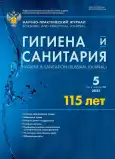Гигиеническая оценка качества и безопасности питьевой воды в розлив
- Авторы: Синицына О.О.1, Брагина И.В.2, Гильденскиольд О.А.1, Стрекачева Л.В.1,3, Турбинский В.В.1
-
Учреждения:
- ФБУН «Федеральный научный центр гигиены имени Ф.Ф. Эрисмана» Роспотребнадзора
- Федеральная служба по надзору в сфере защиты прав потребителей и благополучия человека
- ФБУЗ «Центр гигиены и эпидемиологии в Московской области»
- Выпуск: Том 104, № 5 (2025)
- Страницы: 595-600
- Раздел: ГИГИЕНА ПИТАНИЯ
- Статья опубликована: 15.12.2025
- URL: https://rjsvd.com/0016-9900/article/view/689400
- DOI: https://doi.org/10.47470/0016-9900-2025-104-5-595-600
- EDN: https://elibrary.ru/vpifrg
- ID: 689400
Цитировать
Полный текст
Аннотация
Ключевые слова
Об авторах
Оксана Олеговна Синицына
ФБУН «Федеральный научный центр гигиены имени Ф.Ф. Эрисмана» Роспотребнадзора
Email: sinitsyna.oo@fncg.ru
Ирина Викторовна Брагина
Федеральная служба по надзору в сфере защиты прав потребителей и благополучия человека
Email: info@rospotrebnadzor.ru
Ольга Алексеевна Гильденскиольд
ФБУН «Федеральный научный центр гигиены имени Ф.Ф. Эрисмана» Роспотребнадзора
Email: goa@fferisman.ru
Лариса Валерьевна Стрекачева
ФБУН «Федеральный научный центр гигиены имени Ф.Ф. Эрисмана» Роспотребнадзора; ФБУЗ «Центр гигиены и эпидемиологии в Московской области»
Email: strekacheva_lv@cgemo.ru
Виктор Владиславович Турбинский
ФБУН «Федеральный научный центр гигиены имени Ф.Ф. Эрисмана» Роспотребнадзора
Email: turbinskii.vv@fncg.ru
Список литературы
- Захаров К.Е., Синицына О.О., Гильденскиольд О.А., Стрекачева Л.В. Научное обоснование программы лабораторных исследований для оценки безопасности работы акваматов при производстве, транспортировке и реализации питьевой воды в розлив. В кн.: Материалы I Национального конгресса с международным участием по экологии человека, гигиене и медицине окружающей среды «Сысинские чтения – 2020». Сборник тезисов. М.; 2020: 133–8. https://elibrary.ru/zsonsn
- Тихонова Н.А., Мелехин А.Г. Питьевое водоснабжение города Перми. Вестник Пермского национального исследовательского политехнического университета. Строительство и архитектура. 2015; (1): 198–215. https://doi.org/10.15593/2224-9826/2015.1.14 https://elibrary.ru/tyfvnh
- Еремин Г.Б., Мозжухина Н.А., Борисова Д.С., Исаев Д.С., Грибова К.А., Крутикова Н.Н. Регулирование качества и безопасности питьевой воды в розлив (вендинговой питьевой воды). Здоровье населения и среда обитания – ЗНиСО. 2023; 31(5): 34–40. https://doi.org/10.35627/2219-5238/2023-31-5-34-40 https://elibrary.ru/xjmnyj
- Еремин Г.Б., Мозжухина Н.А., Борисова Д.С. Гигиенические проблемы использования воды в автоматах (обзор литературы). Гигиена и санитария. 2023; 102(8): 842–7. https://doi.org/10.47470/0016-9900-2023-102-8-842-847 https://elibrary.ru/retiwu
- Chaidez C., Rusin P., Naranjo J., Gerba C.P. Microbiological quality of water vending machines. Int. J. Environ. Health Res. 1999; 9(3): 197–206. https://doi.org/10.1080/09603129973164
- Murphy J.L., Kahler A.M., Nansubuga I., Nanyunja E.M., Kaplan B., Jothikumar N., et al. Environmental survey of drinking water sources in Kampala, Uganda, during a Typhoid fever outbreak. Appl. Environ. Microbiol. 2017; 83(23): e01706–17. https://doi.org/10.1128/AEM.01706-17
- Мозжухина Н.А., Еремин Г.Б., Карелин А.О., Борисова Д.С., Исаев Д.С., Грибова К.А. Обеспечение качества и безопасности вендинговой питьевой воды. Здоровье – основа человеческого потенциала: проблемы и пути их решения. 2023; 18(1): 188–99. https://elibrary.ru/ezbflu
- Саканская-Грицай Е.И. Проблемы и перспективы совершенствования водоподготовки. Технико-технологические проблемы сервиса. 2014; 29(3): 88–95. https://elibrary.ru/swnccr
- Цветков А.С., Буймова С.А., Бубнов А.Г., Буймов С.Д. Оценка качества питьевой воды в торговых автоматах. В кн.: Актуальные вопросы естественных наук. Актуальные вопросы естествознания. Сборник материалов Всероссийской научно-практической конференции. М.; 2022: 466–72.
- Yongyod R. Drinking water quality and evaluation of environmental conditions of water vending machines. Asia-Pac. J. Sci. Tech. 2018; 23(1): 1–6.
- Xu Y., Chen R., Zeng Q. Ferroptosis as a mechanism for health effects of essential trace elements and potentially toxic trace elements. Biol. Trace Elem. Res. 2023; 201(9): 4262–74. https://doi.org/10.1007/s12011-022-03523-w
- Water Vending Machine, Inspection Procedure & Operating Requirements. California Department of Public Health; 2014.
- Cardaci R., Burgassi S., Golinelli D., Nante N., Battaglia M.A., Bezzini D., et al. Automatic vending-machines contamination: a pilot study. Glob. J. Health Sci. 2016; 9(2): 63. https://doi.org/10.5539/gjhs.v9n2p63
- Hile T.D., Dunbar S.G., Sinclair R.G. Microbial contamination of drinking water from vending machines of Eastern Coachella Valley. Water Supply. 2021; 21(4): 1618–28. https://doi.org/10.2166/ws.2020.372
- Liu H., Whitehouse C.A., Li B. Presence and persistence of Salmonella in water: the impact on microbial quality of water and food safety. Front. Public Health. 2018; 6: 159. https://doi.org/10.3389/fpubh.2018.00159
Дополнительные файлы









